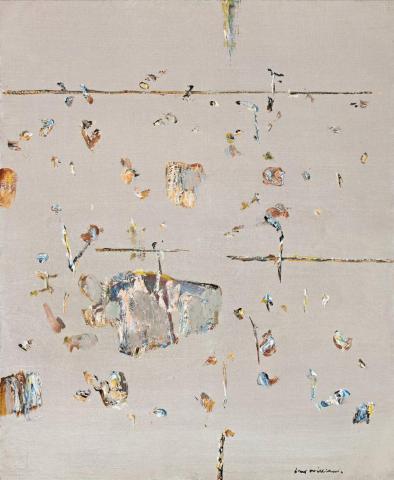PONDS, LYSTERFIELD, 1966
FRED WILLIAMS
oil on canvas
86.0 x 71.0 cm
signed lower right: Fred Williams
Private collection, Victoria, acquired directly from the artist
Private collection, Melbourne
Ponds, Lysterfield, 1965–66, etching and aquatint, in Mollison, J., Fred Williams: Etchings, Rudy Komon Gallery, Sydney, 1968, cat. 225, p. 129 (illus. Fig. 252)
The paintings that Fred Williams exchanged with fellow artists were always special, invariably among his best. This is certainly so with Ponds, Lysterfield 1966, which raises invention and subtlety of vision to a level of singularity that led us to see the Australian landscape with different eyes. As James Gleeson wrote of Williams's sell-out exhibition of 1966 at Rudy Komon's Gallery in Sydney - 'It has been clear for some time that Williams was a landscapist of rare distinction, but this exhibition places him in that thinly populated category of painters who have helped to shape the vision a country has of itself.'1 Part of the miracle of Williams's art is its transformation of the subject, especially its scrubbiness and monotony, into paintings elegant, rich in colour, textural variation and imagination.
Lysterfield Landscape I 1965-66, collection of Rupert Murdoch, was one of the highlights of the 1966 exhibition. The largest among the many fine Lysterfield paintings is Lysterfield Triptych 1967-68, in the collection of the National Gallery of Australia, Canberra. Williams frequently visited the Lysterfield region from the winter of 1965 onwards. It was not very far from his then home at Upwey. He painted there over a number of years into the 1970s, major works such as in Hillside at Lysterfield I and II of 1967 (private collections), capturing the changing light and colours of the seasons. With its predominance of cool tones, Ponds, Lysterfield 1966 evokes winter. The scrubby but empty countryside is created by a few impastoed strokes of the brush across a smooth field of velvety greys.These expressionist textures also contrast against the balance achieved through the accent on verticals and horizontals, and the classical association they give to the composition. A masterpiece of minimalism, the absence of a horizon line achieves greater harmony, earth and sky are one, supported by the multi-viewpoint and its combination of motifs seen from above and in profile. His art is 'both intimate and remote' wrote Elwyn Lynn in The Bulletin of Williams's 1966 exhibition.'2 Williams's remote intimacy is almost Chinese in its mixture of immediate gesture, of spontaneous notation, with contemplation and serenity', he continued. In Ponds, Lysterfield the landscape provided Williams with the inspiration for a singular, lyrical essay on the Australian scene in all its casual formality. It is a painting of ineffable beauty.
1. Gleeson, J., 'Williams is at His Best', Sun, Sydney, 12 October 1966
2. Lynn, E., 'Poetic Bushland', Bulletin, Sydney, 22 October 1966, p. 54
DAVID THOMAS
